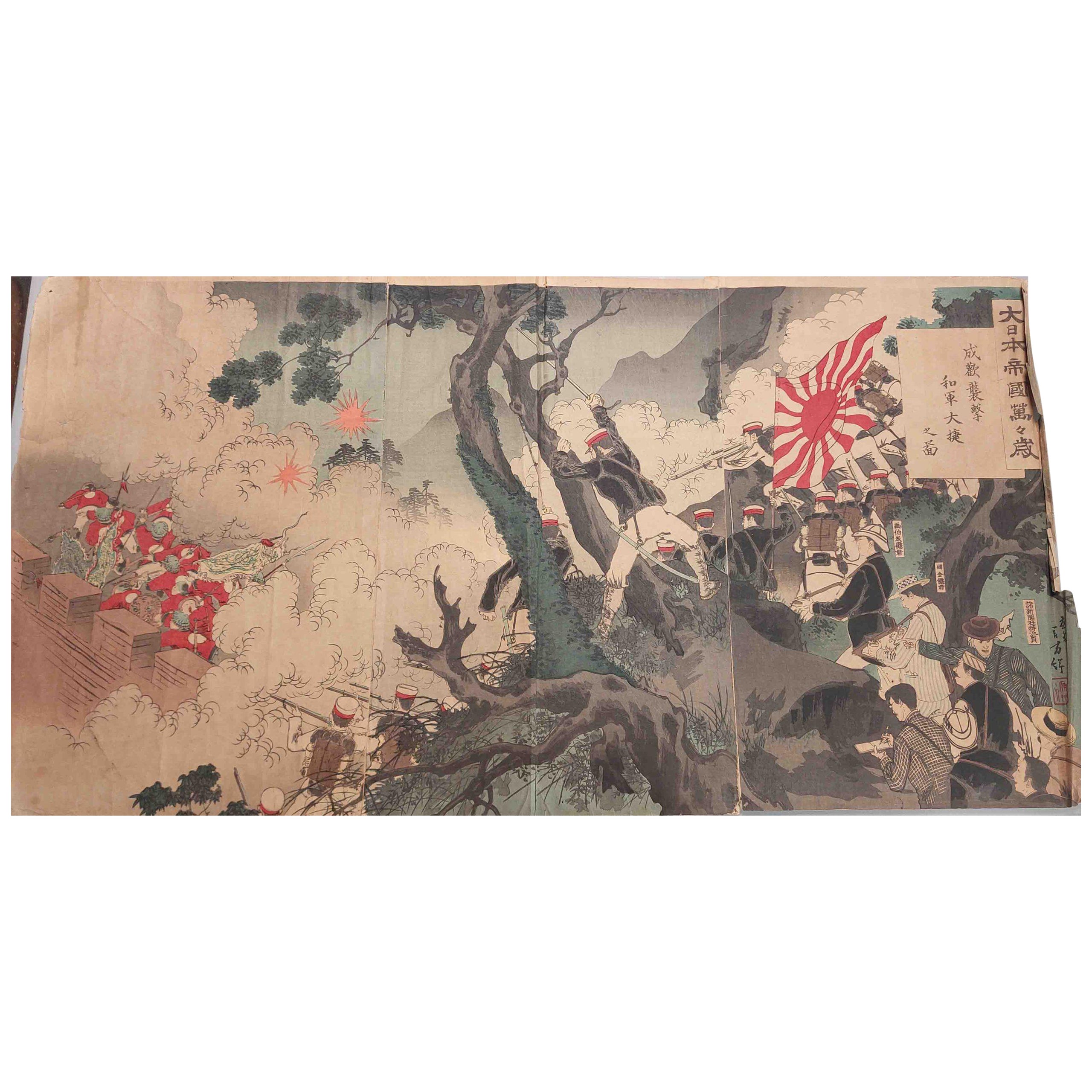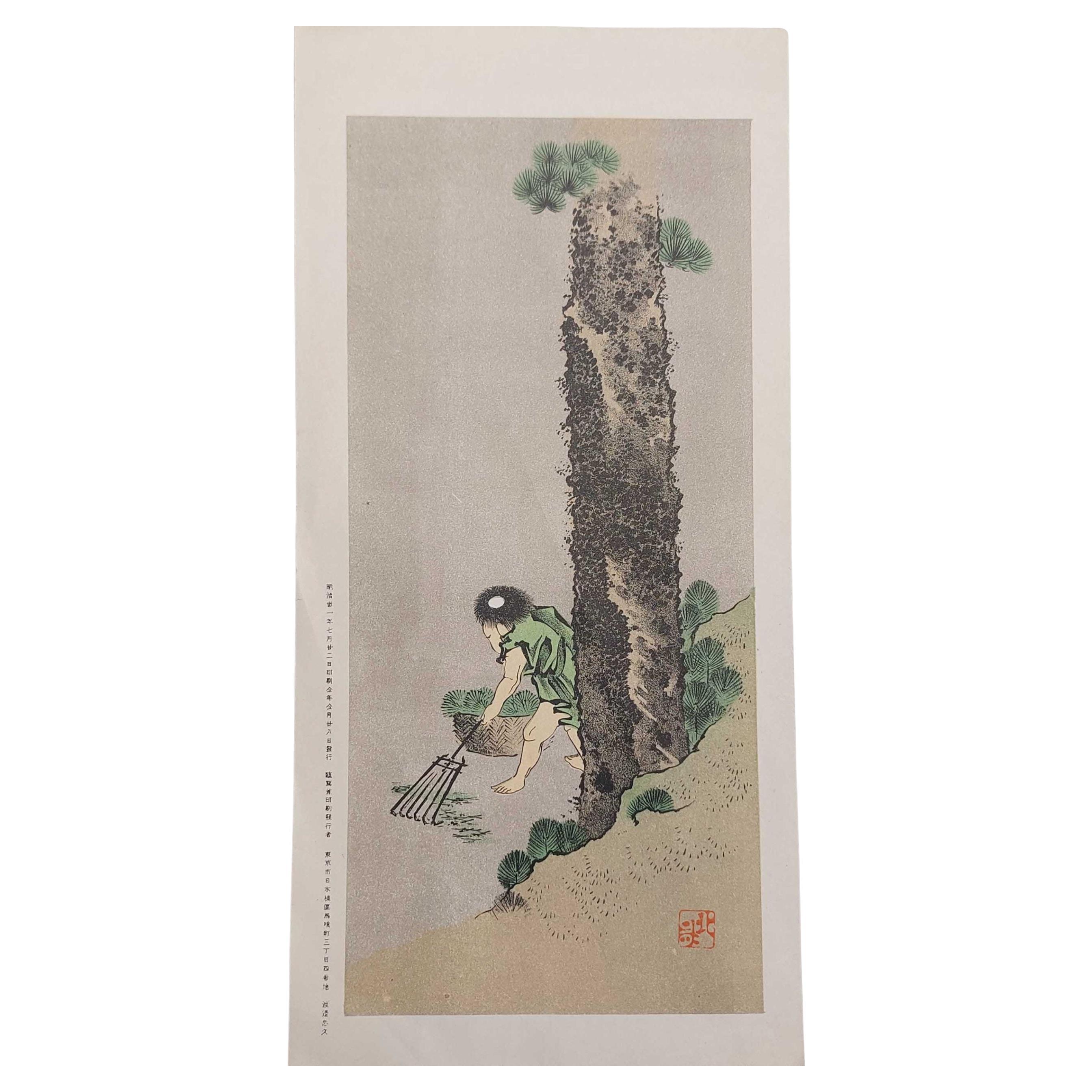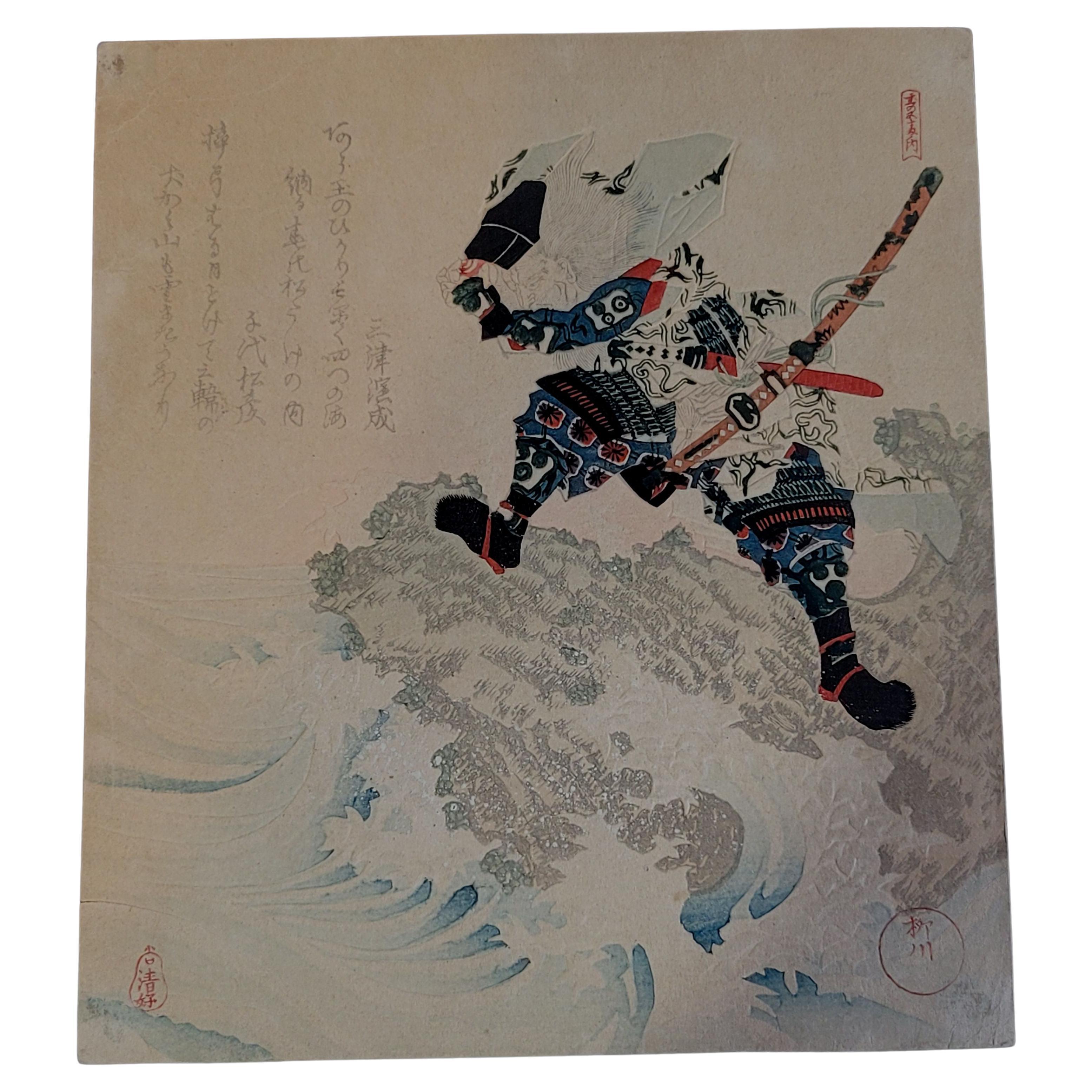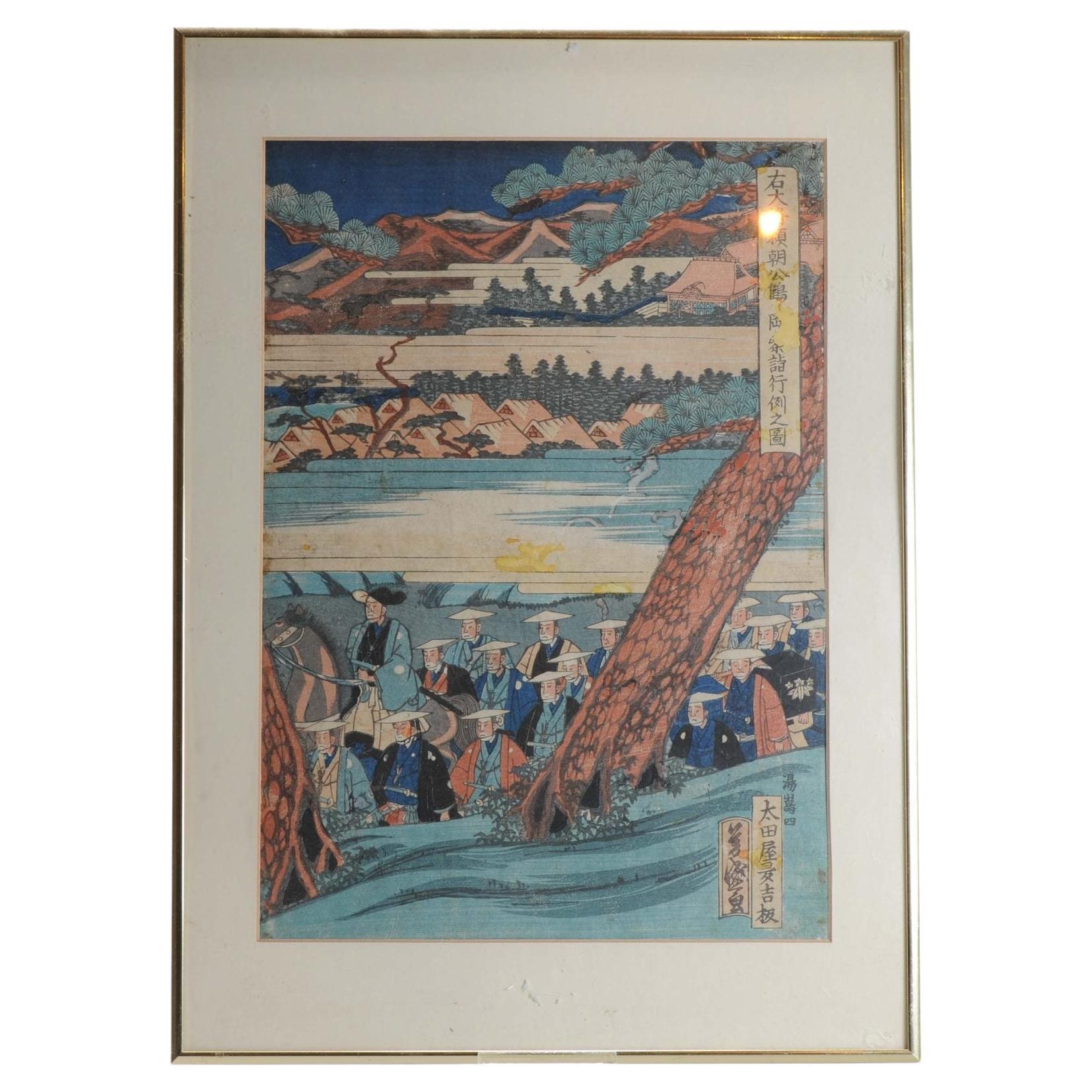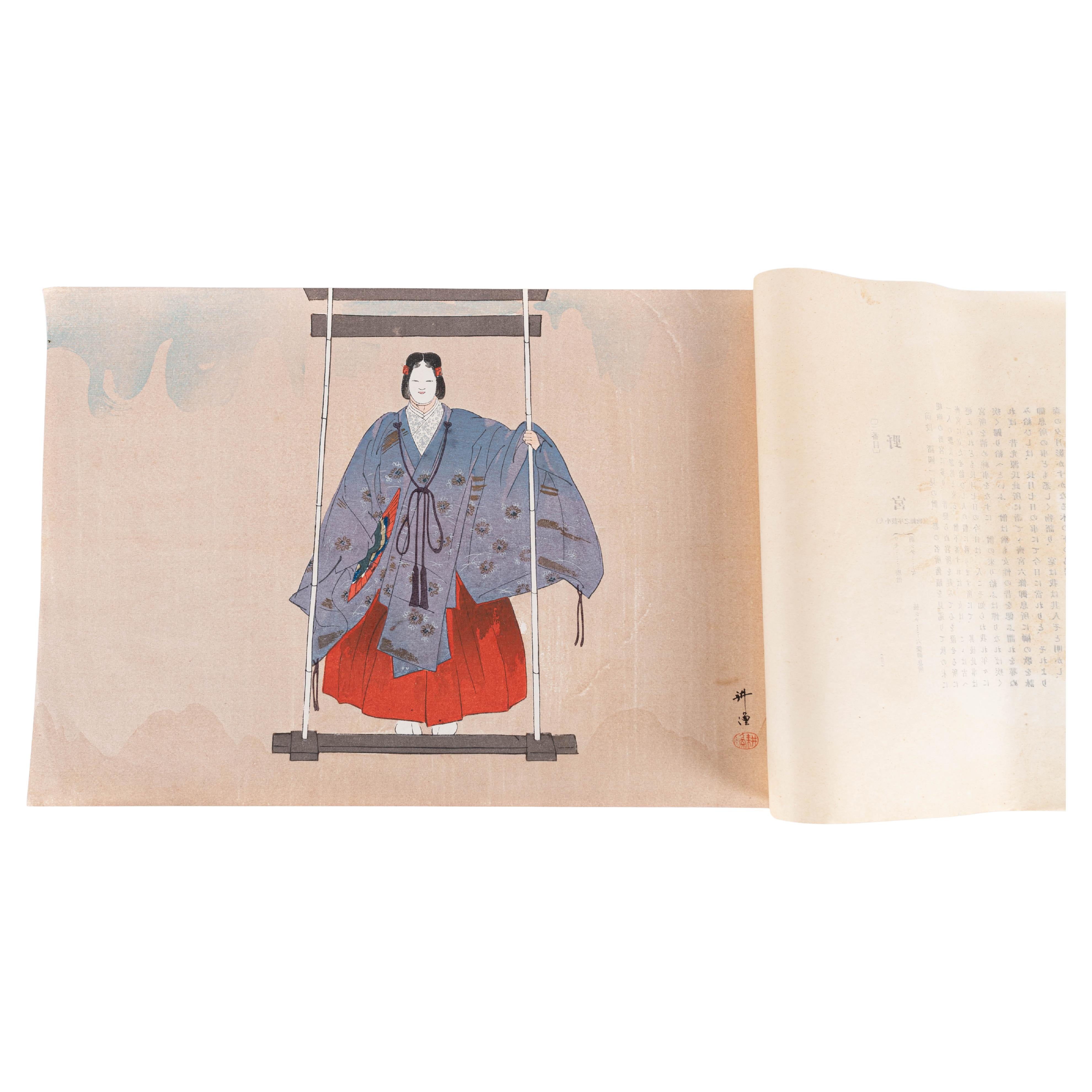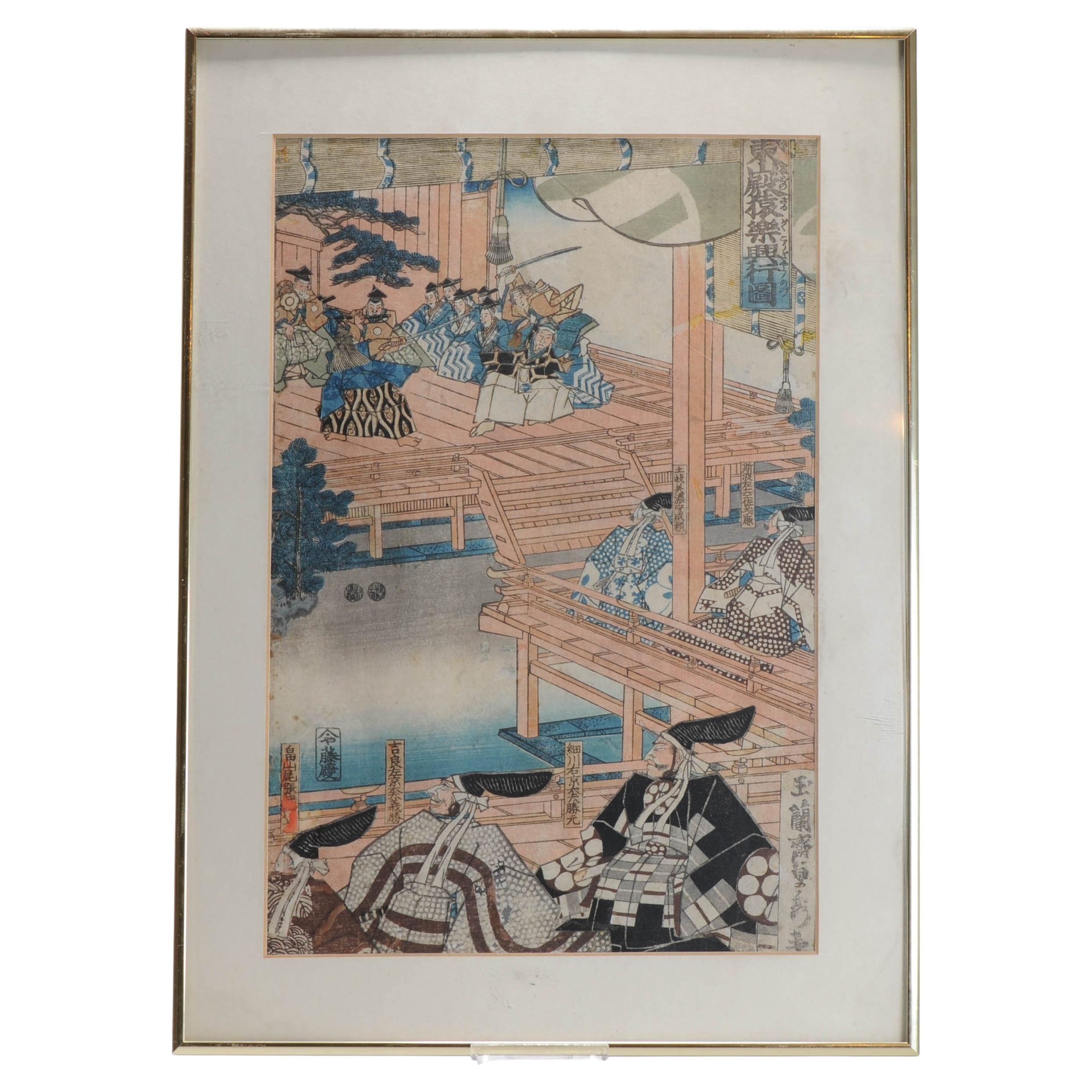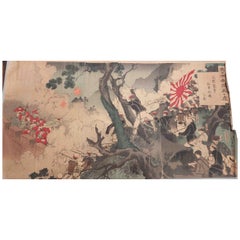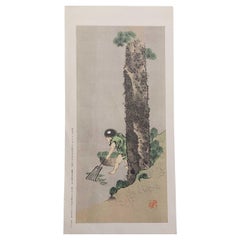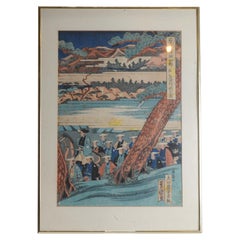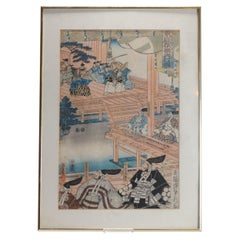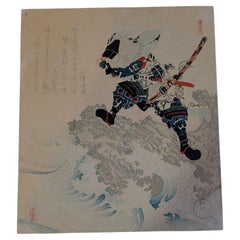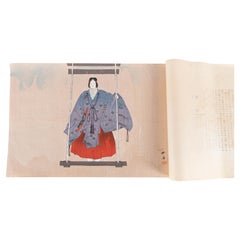Items Similar to Antique 19th c Woodblock Print by Mizuno Toshikata - Sino Japan Battle_of_Son.
Want more images or videos?
Request additional images or videos from the seller
1 of 12
Antique 19th c Woodblock Print by Mizuno Toshikata - Sino Japan Battle_of_Son.
$1,274.40
$1,592.9920% Off
£944.40
£1,180.5020% Off
€1,064
€1,33020% Off
CA$1,739.79
CA$2,174.7420% Off
A$1,935.45
A$2,419.3120% Off
CHF 1,014.59
CHF 1,268.2320% Off
MX$23,650.69
MX$29,563.3620% Off
NOK 12,919.48
NOK 16,149.3520% Off
SEK 12,161.90
SEK 15,202.3820% Off
DKK 8,101.20
DKK 10,126.5020% Off
Shipping
Retrieving quote...The 1stDibs Promise:
Authenticity Guarantee,
Money-Back Guarantee,
24-Hour Cancellation
About the Item
A very strong woodblock print
Long live the Great Japanese Empire! Our army's victorious attack on Seonghwan, Mizuno Toshikata 1866–1908
or
Hurrah and Hurrah Again for the Great Empire of Japan! Great Victory for the Japanese Army in the Assault on Seonghwan
A unique print thats in many musea around the world
About This Print
Battle of Songhwan Observed by Japanese War Correspondents
Source: Impressions of the Front: Woodcuts of the Sino-Japanese War, Shunpei Okamoto, Philadelphia Museum of Art, 1983, p. 20.
Eight war correspondents are shown observing the Japanese assault on Chinese troops at Songhwan1 成歓作戦 Korea on July 29, 1894. The foremost reporter in this scene, the white-capped Kubota Beisen (1852-1906) , was also a painter, whose observations are recorded in a series of pictorial reports on the Sino-Japanese War . He wrote:
The company taking the left wing arrived atop the heights northeast of Songhwan at 5:20 AM and, having dug in, started shelling the enemy camp, which was well within range, causing a great deal of damage and a great number of casualties. The infantry also advanced.
With a full strike force our men captured five enemy camps by 7:30 AM and the battered Chinese fled, leaving countless quantities of ammunition and supplies, including eight field guns. In these two hours of fierce battle, China suffered five hundred casualties, and Japan, ninety, including two officers.
1 The Battle of Songhwan (a fort northeast of Asan) is sometimes referred to as the Battle of Asan. Asan, a stronghold south of Seoul, was occupied by the Japanese the next day without a fight.
Source: The Sino-Japanese War, Nathan Chaikin, self-published, 1983, p. 67.
It was the first battle fought by Japan in a foreign war in three hundred years, and it was the first experiment of a new army organized entirely on the European system. Although the Japanese were confident of success, it must have been satisfying to them to find their expectations so fully realized. The Asan campaign was a small affair, but its prompt execution showed that the generals knew how to command, and that the army organization worked smoothly, even in a country without good roads.
Kubota Beisen - Artist and War Correspondent
Source: Japan at the Dawn of the Modern Age – Woodblock Prints from the Meiji Era, Louise E. Virgin, Donald Keene, et. al., MFA Publications, 2001, p. 68.
A unique and important source of inspiration for the Sino-Japanese War print artists was the journalistic reports written and illustrated by the Kyoto painter Kubota Beisen (1852-1906) , pictured on the left. Accompanied by his two sons, Beisai and Kinsen, Beisen actually followed the troops and recorded their battles in words and sketches. And Beisen himself was depicted almost as a war hero in a small number of triptych designs. One such print by Toshikata (dated August 1894) shows Beisen and his younger son, Kinsen, among the eight foreign correspondents who observed the assault on Songhwan on July 29, 1894, three days before Japan’s official declaration of war. Beisen, wearing a white pith helmet and a black jacket, and Kinsen, wearing a flat-brimmed straw hat and a white suit with blue stripes, are both sketching battle scenes with brush and ink on portable drawing desks. One can catch a glimpse of Kinsen’s drawing of soldiers in the print.
Source: In Battle's Light: Woodblock Prints of Japan's Early Modern Wars, Elizabeth de Sabato Swinton, Worcester Art Museum, 1991, p. 72.
Followed with interest in newspapers and weekly magazines throughout Japan and the world, the Sino-Japanese War introduced a new occupation to the Japanese - war correspondent. This print documents the new phenomenon and identifies those who accompanied the army in the assault on Songhwan on July 29, 1894, before the formal declaration of war. The figures on the right are simply classified as "newspaper correspondents" (sho-shimbusnsha tokuhain), but those on the left are identified by name - "artist Kinsen" (gahaku Kinsen-kun) and "artist Beisen" (gahaku Beisen-kun). Kubota Beisen (1852-1906), wearing the white pith helmet, was a well-known Kyoto painter. The most important Japanese reporter at the front, he sent eyewitness reports and illustrations that are a primary source of information on the battles. His son Kinsen (1875-1954) was a correspondent during both the Sino-Japanese and Russo-Japanese wars.
https://www.artic. edu/artworks/223519/long-live-the-great-japanese-empire-a-great-victory-for-our-troops-in-the-assault-on-songhwan-dai-nihon-teikoku-banbanzai-seikan-shugeki-waga-gun-taisho-no-zu
Condition
Used condition, damages to the margins and rims. Folding and ripping. Size: 70x37cm
Period
19th century
- Dimensions:Height: 14.77 in (37.5 cm)Width: 27.96 in (71 cm)Depth: 0.08 in (2 mm)
- Style:Meiji (Of the Period)
- Materials and Techniques:Bronze,Cloissoné
- Place of Origin:
- Period:
- Date of Manufacture:19th century
- Condition:
- Seller Location:Amsterdam, NL
- Reference Number:Seller: 1447151886491stDibs: LU4863242457952
About the Seller
5.0
Platinum Seller
Premium sellers with a 4.7+ rating and 24-hour response times
Established in 2015
1stDibs seller since 2019
264 sales on 1stDibs
Typical response time: 2 hours
- ShippingRetrieving quote...Shipping from: Amsterdam, Netherlands
- Return Policy
Authenticity Guarantee
In the unlikely event there’s an issue with an item’s authenticity, contact us within 1 year for a full refund. DetailsMoney-Back Guarantee
If your item is not as described, is damaged in transit, or does not arrive, contact us within 7 days for a full refund. Details24-Hour Cancellation
You have a 24-hour grace period in which to reconsider your purchase, with no questions asked.Vetted Professional Sellers
Our world-class sellers must adhere to strict standards for service and quality, maintaining the integrity of our listings.Price-Match Guarantee
If you find that a seller listed the same item for a lower price elsewhere, we’ll match it.Trusted Global Delivery
Our best-in-class carrier network provides specialized shipping options worldwide, including custom delivery.More From This Seller
View AllAntique Woodblock Print by Mizuno Toshikata- Sino Japan Battle of Songhwan
Located in Amsterdam, Noord Holland
A very strong woodblock print
Long live the Great Japanese Empire! Our army’s victorious attack on Seonghwan, Mizuno Toshikata 1866-1908.
or
Hurrah and Hurrah Again for the Great...
Category
Antique 19th Century Japanese Prints
Materials
Paper
Antique 19th c Woodblock Print - Meiji Period 19th century
Located in Amsterdam, Noord Holland
The painter is unknown to me so far
Condition
Perfect Size: 26.5 x12.5 cm
Period
19th century
Category
Antique 19th Century Japanese Meiji Prints
Materials
Paper
$459 Sale Price
20% Off
Antique Edo Period Woodblock Print, War Lords, 19th Century
Located in Amsterdam, Noord Holland
I have not been able to find this print. Its certainly Edo period
Additional information:
Material: Paper
Region of Origin: Japan
Period: 19th century
Decoration Type / Colour: Poly...
Category
Antique 19th Century Japanese Edo Prints
Materials
Paper
Antique Edo Period Woodblock Print by Utagawa Sadahide, Lord Higashiyama, 19th C
Located in Amsterdam, Noord Holland
Performance of Sarugaku for Lord Higashiyama (Higashiyama dono Sarugaku kōgyō no zu)
Utagawa Sadahide
In 1465 the shogun Ashikaga Yoshimasa (1436-1490) commissioned the palace retrea...
Category
Antique 19th Century Japanese Edo Prints
Materials
Paper
Antique 19th c Woodblock Print by Sino Japan War Naval Battle Haiyang Island
Located in Amsterdam, Noord Holland
A very strong woodblock print
- Fantastic depiction of the naval Battle of Haiyang Island during the Sino-Japanese War. An explosion rocks a Chinese ship at right, severing the mast...
Category
Antique 19th Century Chinese Meiji Paintings and Screens
Materials
Bronze
$1,274 Sale Price
20% Off
Antique 19th c Woodblock Print - Hiroshige - Yoshiwara: The Fifty-Three Stati
Located in Amsterdam, Noord Holland
Yoshiwara: Mount Fuji on the Left (Yoshiwara, hidari Fuji), from the series Fifty-three Stations of the Tôkaidô Road (Tôkaidô gojûsan tsugi no uchi), also known as the First Tôkaidô ...
Category
Antique 19th Century Chinese Meiji Paintings and Screens
Materials
Bronze
$517 Sale Price
20% Off
You May Also Like
Japanese Woodblock Print by Yanagawa Shigenobu 柳川重信 '1787-1832'
Located in Norton, MA
Japanese woodblock print (1823) by Yanagawa Shigenobu 1787-1832, unframed.
About the artist
Born in Yanagawa in 1787, Shigenobu worked as a puppet...
Category
Antique Early 19th Century Japanese Prints
Materials
Paper
Original Woodblock print Japan (1925), by Tsukioka Kogyo
Located in Oostende, BE
Original Woodblock print Japan (1925), by Tsukioka Kogyo. From the series ‘Noga Taikan’.
Based on characters of Noh Plays
Category
Vintage 1920s Japanese Prints
Materials
Paper
Japanese Woodblock Print by Yanagawa Shigenobu 柳川重信 '1880 version"
Located in Norton, MA
Japanese woodblock print (1823) by Yanagawa Shigenobu 1880 version, unframed.
About the artist
Born in Yanagawa in 1787, Shigenobu worked as a puppet maker before a successful care...
Category
Antique 1880s Japanese Prints
Materials
Paper
STUNNING ANTIQUE MEIJI PERIOD SHIGA SHIGEAKI FAMILY ESTATE WOODBLOCK PRiNT
Located in West Sussex, Pulborough
Royal House Antiques
Royal House Antiques is delighted to offer for sale this stunning original Meiji period circa 1880 Japanese print of Shiga Shigeaki’s family estate in the origi...
Category
Antique 1880s Chinese Chinese Export Prints
Materials
Paper
Original Japanese Woodblock Print by Totoya Hokkei 19th Century
By Totoya Hokkei
Located in Auribeau sur Siagne, FR
Rare, original Utagawa Hiroshige 19th century woodblock print. Beautiful Edo period print from the original publisher. Museum quality framed with con...
Category
Antique 19th Century Japanese Chinese Export Prints
Materials
Paper
$2,395 Sale Price
20% Off
Japanese Woodblock Print by Hokusai Katsushika, 葛飾北齋 '1760~1849'
Located in Norton, MA
Original Japanese Woodblock print by Hokusai Katsushika, ???? '1760-1849'
About the artist
Japanese artist, Hokusai Katsushika, was born in Edo as Tamekazu Nakajima. Adopted by...
Category
Antique Early 19th Century Japanese Prints
Materials
Paper
More Ways To Browse
19th Century Ink Wells
Gold Chinese Screen
Japanese Shell Art
Antique European Screen
Small Asian Screens
Japanese Screen Kyoto
Antique Camp Furniture
Helmet Bronze
Antique Men Hats
Winged Victory
Chinese Desk 19th
Chinese Woodblock
Kyoto Screens
Chinese Soldier
Antique Drawing Desk
Japanese Brush Painting
Antique Soldier Painting
Japanese Straw
